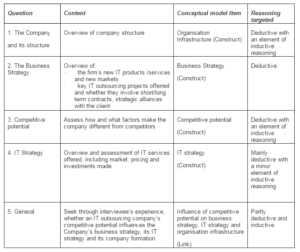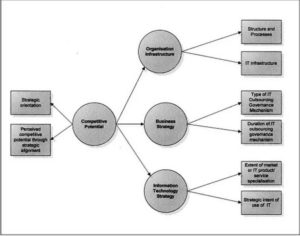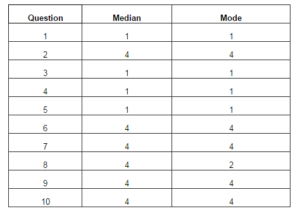Table 3 Goodness of Fit Measures
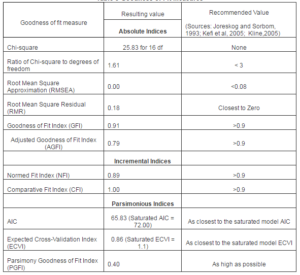
Most indices indicated in Table 3 suggest acceptable values to the proposed model. Additionally, as indicated in Table 4 below, the estimated correlations among constructs are not excessively high indicating an acceptable level of distinctiveness between them.
Table 4 Correlations between Latent Constructs
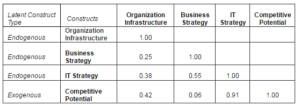
The correlations (standardised regression coefficients) pose another form of evaluation. According to Cohen (1988), correlations between 0.10 and 0.29 represent small influence, correlations between 0.30 and 0.49 represent medium influence, and correlations between 0.5 and 1.0 represent large influence. According to the model, the correlation between competitive potential and IT strategy (0.91) represents a large influence that for Business Strategy (0.60) represents a medium influence, whilst that for organisation infrastructure (0.42) represents a small influence.
Additionally the resulting path model, shown in Fig 2, indicates the effect of competitive potential on IT strategy, which accounts for 82 percent of its variance (0.912) followed by that on Business Strategy, which accounts for 36 percent of its variance (0.602), and finally on the Organisation Infrastructure which accounts for 16 percent of its variance (0.422).
The results also indicate that the competitive potential accounts for 59 percent (0.772) in the variance of the vendor’s strategic focus for the firm (e.g. innovative focus, cost reduction focus) and that the IT strategy accounts for 42 percent (0.642) in the variance of the specialist nature of the IT product/service or its market.
In essence, the findings indicate that IT product or service offering of the IT outsourcing service provider plays a key role in establishing and sustaining the firm’s competitive potential. The strong relationship between IT strategy and the competitive potential of the vendor firms, and the significant corresponding measure variances attributed to both constructs may be further confirmed by various literature contributions. Venkatraman et al. (1991) refers to the convergence of two concurrent forces that define the role for IT within organizations, and hence the IT strategy to be adopted by the vendors – the ‘technology push’ and the ‘competitive pull’ experienced by the vendor firms. The technology push is attributed to the dynamic nature of IT which leads to changes in the strategic relevance of IT to organisations (McFarlan et al., 1995). The effect of such changes lead to significant improvements in the price performance ratio of IT and to new modes of IT service provision by third parties (Currie et al., 2003). The developments are also in line with evolvements in the applicability of IT by the Maltese client base. It mainly targets support or operational processes within organisations. In effect, it is used as a means to achieve reduced costs and improved service delivery (Barakao and Gatere, 2008) which may lead to the exploitation of IT capabilities in all the possible areas within a business process. The competitive pull, on the other hand, is a result of intense rivalry which is prevalently high in a small economy like Malta. Briguglio and Cordina (2004) contend that a ‘small country cannot support a large number of firms producing a similar product’. In the case of small firms, both Namiki (1985) and Taylor et al. (1990) report a tendency for small firms to focus on a particular product market segment or particular set of customers as a means to overcome their hurdles.
The findings also indicate that the business strategy construct accounts for 74 percent (0.862) of the variance in the type of relationship between the vendor and the client and for 11 percent (0.332) of the variance in the duration of the relationship. In their study, Kern and Willcocks (2004) find that contract complexity, is ‘a significant factor to consider, especially in terms of operability’ (p.358). This is particularly so, as stated in Williams (1975), ‘in IT outsourcing [whereby] the greater the complexity, the more intensive the demand for interorganisational interactions and hence the higher transaction costs’ (as cited in Kern and Willcocks, 2001, p.65). Various studies note such diverse forms of contract complexities or governance mechanisms as contingent to the IT product and service offered by the vendor to the customer on a number of parameters, such as the degree of application of IT induced business transformations in customer organisations (Venkatraman et al., 1991); the longitudinal strategic application of IT (McFarlan et al., 1995); the balanced application of IT for competitive positioning and business operations (Kern and Willcocks, 2001) and the use of IT based on its mature applicability in the customer firm and its use for business integration (Feeny et al., 1989; Kern and Willcocks, 2001). Additionally, Oliver (1990) attributes ‘the stability of an interorganisational relationship as a coping strategy to forestall, forecast or absorb uncertainty in order to achieve an orderly reliable pattern of resource flows and exchanges’ (Kern and Willcocks, 2001, p.66). Such stability is inferred too by Kern and Wilcocks (2001) as ‘the continuity of the relationship focussing on the contractual time frame and/or expected continuity of the outsourcing relationship’ (p.66).
The resulting model also indicates that organisation infrastructure construct just accounts for only 5 percent (0.232 ) in the variance of the organisation structure and processes. Lawrence and Dyer (1993) identify a number of organisational forms that they feel are most appropriate for each combination of information complexity, that is, the diversity and uncertainty of the technology and the resource scarcity accentuated by high competitive potential in the IT sector. For example, a fluid and responsive organisation structure is noted as essential in an organisation dealing with a complex and dynamic environment and high levels of competition (Buono and Kerber, 2010; Carnall, 1990). In addition, Mintzberg (1993) contends that ‘many small organisations, however, remain with a simple structure beyond their formative years’ (p. 159). The simple structure is defined as ‘one where its environment tends to be comprehended and controlled by one individual — the decision maker and is at the same time simple — non sophisticated and non regulated and dynamic — an organic structure’. It is also one that is characterised by the entrepreneurial firm, whereby the classic case is the owner-managed firm. This may indeed be the case, considering that 67 percent of the respondents of the questionnaire leading to the formation of the path model are micro-enterprises.
In conclusion, the model derived through the applicability of Structured Equation Modelling and that is largely based on data from micro-enterprises, confirms a positive relationship between the competitive potential and the coalignment of business, IT strategies and organisation infrastructure, based upon the outcomes of Findings 1, 2 and 3 that are summarised in Table 5 below. The findings appear to follow Henderson and Venkatraman’s definition with respect to the ‘competitive potential perspective’ whereby:
- the IT strategy is defined as the domain that has the greatest strength
- the business strategy is the weaker quadrant which will receive focus and where changes will be addressed by the IT strategy
- the organisation infrastructure is the impacted domain as it is directly affected by change to the business strategy (Abou-Zeid, 2002; Paap, 2002; Henderson and Venkatraman, 1993; Luftman, Lewis and Oldach, 1993).
Table 5 – Findings through Structured Equation Modelling
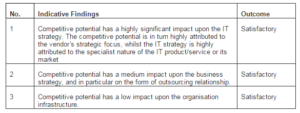
Specifically, the IT strategy is indeed one major area of focus for a micro-enterprise IT outsourcing vendor, particularly with respect to IT investments made and to the degree of specialisation of the IT product and/or service offered and/or the market targeted. Specialisation may in particular enable such firms to survive in a highly volatile and competitive industry as that for IT. Domberger (1998, p. 51) argues that it may also provide tangible economic benefits to both the vendor and the customer in that, by concentrating on activities in which an organisation is relatively more efficient, total value added is maximised.
Case-Study Data Analysis and Findings
The outcome of the multiple case study is presented in Table below.
Table 6 – Findings through the Multiple Case Study Approach
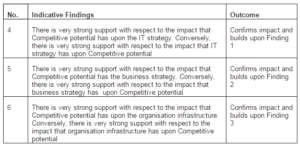
The key case study findings confirm the findings through the SEM model, whereby an IT outsourcing vendor firm’s competitive potential is an influential factor upon the firm’s IT strategy, business strategy and organisation infrastructure. They also indicate that competitive potential is shaped by the IT outsourcing vendor firm’s IT strategy, business strategy and organisation infrastructure. The findings also lead to conclusions that:
- each strategic and organisational related function needs to be undertaken within the context of influence from and upon the other strategic or organisational function within the IT outsourcing organisation.
- the external environment has an overall influence, albeit indirectly, on the vendor’s competitive potential.
Limitations
The findings of the research need to be interpreted with few limitations in mind. It is seen as a case which cannot be easily replicated. The survey is conducted within a small developing economy, where the IT outsourcing vendor’s community amounted to less than 150 firms. Most surveyed firms employed less than 10 often family related employees generally considered as micro-sized organisations in EU. Additionally, the operational proximity of firms in Malta is relatively small and often overlapping, leading towards tendency for mistrust and fear by some firms to divulge information through surveys or even through interviews.
Conclusion
The research has provided an insight into the competitive potential of micro sized firms offering IT outsourcing products and services operating within a micro European Union island state. The IT outsourcing governance mechanisms as the vendor firms’ business strategy are of secondary, albeit significant impact upon the competitive potential of the firms. The IT strategy of IT outsourcing vendors is playing the most significant role, acting as the key ‘anchor domain’ as termed by Henderson & Venkatraman (1993) in their Strategic Alignment Modelling for a Competitive Potential perspective. Indeed as these results suggest, the findings indicate that the IT strategy adopted by the IT outsourcing vendor firm is significantly shaped by the specialist nature of the IT product/service and/or its market. The firm’s major domain for competitive potential has been largely assessed through cost reductions and efficiency gains within the organisation. The specialist focus in the product/service offer and/or the market reflects the tendency stated earlier with respect to micro-sized firms, as their only means to overcome hindrances to success.
Ultimately, as confirmed through the case study findings, there is the need for alignment of strategic, organisational and competitive factors within a micro-enterprise IT outsourcing firm, in order to generate competitive potential that is sustainable. It could be noted that competitive potential cannot be based solely on core capabilities and efforts, which in micro-enterprises can be particularly lacking or constrained in terms of, for example, availability of skills, efforts in research and development, financial depth and effort. Competitive potential is rather a dynamic capability that evolves out of well conceived business strategy, IT strategy and organisation infrastructure that seek to exploit existing competitive advantages and compensate for resource constraints whilst seeking to deliver service and/or product through outsourcing arrangements. Hence IT strategy, business strategy and organisation infrastructure cannot be formulated in isolation, since, essentially, they all have impacted one another.
Last but not least, it is noted that the external environment has an overall influence, albeit indirectly, on the vendor’s competitive potential. The form of IT outsourcing relationship, including informal long term sustainable relationships, between the vendor and the customer is only one facet. Equally important are relationships between the vendor and its suppliers , often as indicated, with larger rival IT firms as a means to secure otherwise unsustainable markets in a fiercely competitive environment. Technology developments, as well as global, regional and national economic challenges are also seen as catalysts for changes within the IT vendor organisations themselves which may in turn lead to new opportunities for market growth for long term competitive sustainability. However, such factors merit further elaboration which remains for future research to delve deeper into.
References
Akalu, M. M. (2002). Projects for Shareholder Value: A Capital Budgeting Perspective, Internet Link, (accessed on 26/2/2011)
Publisher – Google Scholar
Al-Qirim, N. (2010). “E-Commerce Innovations in Jordan: Theoretical Model Development and Implications for Small Businesses,” AMCIS 2010 Proceedings,
http://aisel.aisnet.org/amcis2010/14 (accessed on 7 March 2011)
Publisher – Google Scholar
Altinkemer, K., Chaturvedi, A. & Gulati, R. (1994). “Information Systems Outsourcing: Issues and Evidence,”International Journal of Information Management, 14, 252-268
Publisher – Google Scholar – British Library Direct
Ang, J. S. (1991). ‘Small Business Uniqueness and the Theory of Financial Management,’ Journal of Small Business Finance 1(1). 1-13
Audet, J. & d’Amboise, G. (2001). “The Multi-Site Study: An Innovative Research Methodology,” The Qualitative Report, 6, http://www.nova.edu/ssss/QR/QR6-2/audet.html (accessed on 23 August 2010).
Publisher – Google Scholar
Baldacchino, G. (1999). “Small Business in Small Islands: A Case Study from Fiji,” Journal of Small Business Management, 37
Publisher – Google Scholar – British Library Direct
Barakao, D. G. & Gatere, P. K. (2008). “Outsourcing Practices of the Kenyan Banking Sector,” African Journal of Accounting, Economics, Finance and Banking Research,2
Publisher
Baxter, P. & Jack, S. (2008). “Qualitative Case Study Methodology: Study Design and Implementation for Novice Researchers,” The Qualitative Report, 13 (4). 554-559
Publisher – Google Scholar
Beeson, I. & Al Mahamid, S.(2004). “Survey of Strategic Alignment Indicators in Manufacturing Companies in South-West of England,” In proceeding of the second CEMS Research Student Conference, Bristol, 15 October, 2004.
Publisher
Bergeron, F., Raymond, L. & Rivard, S. (2003). ‘Strategic Alignment of Information Technology: Performance Outcomes in Small and Medium Sized Firms,’ Business Excellence I: Performance Measures, Benchmarking and Best Practices in New Economy, University of Minho, Braga, Portugal, pp. 67-72
Google Scholar
Bin Md Basir, H.(2006). “The Interoperability of Strategic Alignment Model in Malaysian Public Institutions of Higher Learning,” SITMA , Malaysia
Publisher – Google Scholar
Blau, P. M., Heydebrand, W. V. & Stauffer, R. E. (1966). “The Structure of Small Bureaucracies,” American Sociological Review 31,179-191
Publisher – Google Scholar
Blili, S. & Raymond, L. (1993). ‘Information Technology: Threats and Opportunities for SMEs,’ International Journal of Information Management, 13,6,439-448.
Brancheau, J., Janz, B. & Wetherbe, J. (1996). “Key Issues in Information Systems Management: 1994-1995 SIM Delphi Results,” MIS Quarterly, 20, 225-242.
Publisher – Google Scholar
Briguglio, L. & Cordina, G. (2004). ‘Competitiveness Strategies for Small States,’ Briguglio, L. and Cordina, G. (Ed). Published by Formatek Malta, for the Commonwealth Secretariat and the University of Malta. ISBN 9909-49-20-4.
Google Scholar
Carnall, C. (1990). ‘Managing Change in Organisations,’ Prentice Hall International (UK) Ltd.
Chan, Y. & Reich, B. (2007). ‘State of the Art IT Alignment, What Have we Learnt?,’ Journal of Information Technology, 22, 297-315
Google Scholar
Chen, S., Duan, Y., Edwards, J. S. & Lehaney, B. (2006). “Toward Understanding Inter Organizational Knowledge Transfer Needs in SMEs: Insight from a UK Investigation,” Journal of Knowledge Management, 10, 3, 6-23.
Publisher – Google Scholar – British Library Direct
Cheon, M. J., Grover, V. & Teng, J.T.C. (1995). “Theoretical Perspectives on the Outsourcing of Information Systems,”Journal of Information Technology, 10, 209-219.
Publisher – Google Scholar – British Library Direct
Chevez, N. V. (2010). “A Unified Strategic Business and IT Alignment Model, a Study in the Public Universities of Nicaragua,” Licentiate Thesis in Computer and Systems Sciences, Royal Institute of Technology, Stockholm, Sweden
Publisher – Google Scholar
Chin, W. & Newsted, P. R. (1995). ‘The Importance of Specification in Causal Modelling: The Case of End-User Computing Satisfaction,’ Information Systems Research, 6(1). 73-81
Cohen, J. (1988). ‘Statistical Power Analysis for Behavioural Sciences,’ New York: Academic Press (2nd. Ed.)
Google Scholar
Cragg, P. B. & Todorova, N. (2005). “Information Systems Strategic Alignment in Small Firms,” (accessed on 16 February 2011).
Publisher – Google Scholar
Cronk, J. & Sharp, J. (1995). “A Framework for Deciding What to Outsource in Information Technology,” Journal of Information Technology, 10, 259-267.
Publisher – Google Scholar – British Library Direct
Currie, G. & Suhomlinova, O. (2006). “The Impact of Institutional Forces Upon Knowledge Sharing in the UK NHS: The Triumph of Professional Power and the Inconsistency of Policy,” Public Administration, 84(1). 1—30.
Publisher – Google Scholar – British Library Direct
Currie, W. (1995). Management Strategy for IT, FT/Prentice Hall.
Publisher – Google Scholar
Currie, W. (2000). “The Supply-side of IT Outsourcing: The Trend towards Mergers, Acquisitions and Joint Ventures,”International Journal of Physical Distribution and Logistics Management, 30, 3/4/, 238-254.
Publisher – Google Scholar – British Library Direct
Currie, W. L., Desai B., Khan, N., Wang, X. & Weerakkody V. (2003). “Vendor Strategies for Business Process and Applications Outsourcing: Recent Findings from Field Research,” Proceedings of the 36th Hawaii International Conference on System Sciences (HICSS’03).
Publisher – Google Scholar
Damanpour, F. (1991). “Organizational Innovation: A Meta-Analysis of Effects of Determinants and Moderators,”Academy of Management Journal, 34 (3). 555-590
Publisher – Google Scholar
DiRomualdo, A. & Gurbaxani, V. (1997). “Strategic Intent for IT Outsourcing,” Working Paper ITR-140 — Research in collaboration with the sponsoring organizations of CSC Foundation research program.
Publisher – Google Scholar – British Library Direct
Eisenhardt, K. M. (1989). “Building Theories from Case Study Research,” Academy of Management Review, 14(4). 532-550.
Publisher – Google Scholar
European Commission (2010). “Enterprise and Industry, Small and Medium Sized Enterprises,”
http://ec.europa.eu/enterprise/policies/sme/promoting-entrepreneurship/crafts-micro-enterprises/(accessed on 1 December 2010).
Publisher
Feeny, D., Earl, M. & Edwards, B. (1989). “IS Arrangements to Suit Complex Organisations 2: Integrating the Efforts of Users and Specialists,” OXIIM research and discussion paper, Oxford Templeton College.
Publisher – Google Scholar
Fernandez, W. .(2005). “Chapter 5- The Grounded Theory Method and Case Study Data in IS Research: Issues and Design,” in D. Hart and S. Gregor (eds.). Information Systems Foundations Workshop: Constructing and Criticising, Canberra: Australian National University E-Press,
http://epress.anu.edu.au/info_systems_citation.html (accessed on 16 August 2010).
Publisher – Google Scholar
Fish, K. E. & Seydel, J. (2006). “Where IT Outsourcing is and Where it Is Going: A Study across Functions and Department Sizes,” The Journal of Computer Information Systems 46(3):96—103.
Publisher – Google Scholar – British Library Direct
Government of Malta.(2010). “National Policy, Vision 2015,”
https://opm.gov.mt/vizjoni-2015 (accessed on 31 May 2010).
Publisher
Hadjimanolis, A. (2000). “An Investigation of Innovation Antecedents in Small Firms in the Context of a Small Developing Country,” R&D Management, 30(3). Blackwell Publishers Ltd, UK
Publisher – Google Scholar – British Library Direct
Hakannson, H. & Schenota, I. (1995). ‘Developing Relationships in Business Networks,’ Routledge, London.
Google Scholar
Hale, A. J. & Cragg, P. B. (1996). “Business Process Re-Engineering in the Small Firm: A Case Study,” Proquest.
Publisher
Hancox, M. & Hackney, R. (1999). ‘Information Technology Outsourcing: Conceptualising Practice in the Public and Private Sector,’ Proceedings of the 32nd. Hawaii International Conference on System Sciences,1-15.
Hartog, C. & Herbert, M. (1986). ‘Opinion Survey of MIS Managers: Key Issues,’ MIS Quarterly, 10(4).351-361.
Google Scholar
Heath, N. (2009). “Cheat Sheet:Outsourcing — Is it in or Out?,” Silicon.com, 11 September 2009, silicon.com, (accessed on 10 October 2009)
Publisher
Henderson, J. C. & Venkatraman, N. (1993). “Strategic Alignment: Leveraging Information Technology for Transforming Organisations,” IBM Systems Journal, 31(1).4-16.
Publisher
Holmes, S. & Gibson, B. (2001). ‘Definition of Small Business (Final Report),’ The University of Newcastle.
Google Scholar
Hooper,V. A., Huff, S. L. & Thirkell, P. C. (2010). “The Impact of IS-Marketing Alignment on Marketing Performance and Business Performance,” ACM SIGMIS Database, 41,1
Publisher – Google Scholar
Hu, T., Zhang, X. & Teng, W.-Y. (2011). “Understanding Information Technology Configuration in Business Diversification: A Political View,” Information Technology Journal, 10, 470-477
Publisher – Google Scholar
Jensen, M. C. & Meckling, W. H. (1976). “Theory of the Firm: Managerial Behaviour, Agency Costs and Ownership Structure,” Journal of Financial Economics, 3, 305-360
Publisher – Google Scholar
Johnson, G. & Scholes, K. (1993). ‘Exploring Corporate Strategy,’ Prentice Hall Publications
Google Scholar
Jouirou, N. & Kalika, M.(2004). “Strategic Alignment: a Performance Tool (An Empirical Studyo SMEs),” Proceedings of the Tenth Americas Conference on Information Systems, (New York: 2004).
Publisher – Google Scholar
Kaul, M. (1997). “The New Public Administration: Management Innovations in Government,” Public Administration and Development, 17, 13-26
Publisher – Google Scholar – British Library Direct
Kearns, G. S. & Lederer, A. L. (2000). “The Effect of Strategic Alignment on the Use of IS Based Resources for Competitive Advantage,” Journal of Strategic Information Systems, 9, 265-293
Publisher – Google Scholar
Kefi, H. & Kalika, M. (2005). “Survey of Strategic Alignment Impacts on Organizational Performance in International European Companies,” Proceedings of the 38th Hawaii International Conference on System Sciences, 1-10
Publisher – Google Scholar
Klepper, R. (1994). ‘Outsourcing Relationships,’ in Managing IT with Outsourcing, Idea Group Publishing, 218-243
Klepper, R. (1995). “The Management of Partnering Development in I/S Outsourcing,” Journal of Information Technology, 10, 249-258.
Publisher – Google Scholar – British Library Direct
Kline, R. B. (1998). ‘Principles and Practice of Structural Equation Modelling,’ The Guilford Press, NY, USA
Korvela, H. & Packalen, K. (2010). “Looking Beyond the Veil- What Makes the Micro-Organisation End-User Developers Tick?,” AMCIS 2010 Proceedings, 16th Americas Conference on Information Systems, Lima, Peru, August 12-15, 2010
Publisher – Google Scholar
Kudelski & Partner, A. G. (2005). ‘Business Reengineering and Process Management,’ Zurich, www.kudelski.ch
Publisher
Lacity, M. C. & Hirschheim, R. (1993). Information Systems Outsourcing: Myths, Metaphors and Realities, John Wiley and Son, UK.
Publisher – Google Scholar
Lacity, M. C., Khan, S., Yan, A. & Willcocks, L. P. (2010). “A Review of the IT Outsourcing Empirical Literature and Future Research Directions,” Journal of Information Technology, 25, 395—433.
Publisher – Google Scholar
Lacity, M. C. & Willcocks, L. P. (2001). Global Information Technology Outsourcing : In Search of Business Advantage,John Wiley and Sons ISBN 0471899593.
Google Scholar
Lawrence, P. R. & Dyer, D. (1983). ‘Renewing American Industry,’ New York, Free Press
Google Scholar
Lee, J.-N., Miranda, S. M. & Kim, Y.-M. (2004). “IT Outsourcing Strategies: Universalistic, Contingency and Configurational Explanations of Success,” Information Systems Research, 15(2).110-131
Publisher – Google Scholar – British Library Direct
Levina, N., & Ross, J. (2003). “From the Vendor’s Perspective: Exploring the Value Proposition in IT Outsourcing,” MIS Quarterly 27(3).331-364
Publisher – Google Scholar – British Library Direct
Luftmann, J. N., Lewis, P. R. & Oldach, S. H. (1993). “Transforming the Enterprise: The Alignment of Business and IT Strategies,” IBM Systems Journal, 32(1). 198-221
Publisher – Google Scholar – British Library Direct
Mahesha, K. & Lawson, R. (2006). “Barriers to Adopting ICT and e-commerce with SMEs in Developing Countries: An Exploratory Study in Sri Lanka,” CollECTeR ’06, Adelaide
Publisher – Google Scholar
Mahnke, V., Overby, M. L. & Vang, J. (2003). “Strategic IT-Outsourcing: What do we Know and Need to Know,” Draft Version, 1-33,
www.druid.dk/uploads/tx_picturedb/ds2003-892.pdf (accessed on 22 December 2009).
Publisher – Google Scholar
Marrone, M. & Kolbe, L. M. (2010). “Providing More than Just Operational Benefits: An Empirical Research,” MKWI 2010, Performance Management / IT-Controlling 287, (accessed on 7 March 2011)
Publisher – Google Scholar
McFarlan, F. W. & Nolan, R. . (1995). “How to Manage an IT Outsourcing Alliance,” Sloan Management Review.
Publisher – Google Scholar – British Library Direct
Miller, C. C., Glick W. H., Wang, Y. D. & Huber, G. P. (1991). “Understanding Technology-Structure Relationships: Theory Development and Meta-Analytic Theory Testing,” Academy of Management Journal 34(2). 370-399.
Publisher – Google Scholar
Ministry for Investment, Industry and Information Technology (MIT&I). (2007). ‘Information and Communications Technologies – Business Directory,’ Government of Malta.
Mintsberg, H. (1993). Structure in Fives, Designing Effective Organisations, Prentice Hall Publications.
Publisher
Mizzi, M. (2010). ”Innovation and the Maltese SME,” http://grtu.net , (accessed on 26/10/2010).
Publisher
Muhamad, M. R. & Ashari, H. (2005). ‘The Alignment of Competitive Priorities, Process Structure, and IT Applications, and its Effect on Firm Performance: A Proposed Conceptual Model,’ 35th International Conference on Computers and Industrial Engineering, Turkey, 1403-1408.
Google Scholar
Nachtigall, C., Kroehne, U., Funke, F. & Steyer, R. (2003). ‘(Why) Should we Use SEM? Pros and Cons of Structural Equation Modeling,’ Methods of Psychological Research Online, 8(2).1-22
Namiki, N. (1988). “Export Strategy for Small Business,” Journal of Small Business Management, 26, 32-37.
Publisher – Google Scholar
National Statistics Office (2005). “Survey on Information and Communications Technology – Usage of Enterprises 2003,” www.nso.gov.mt, Malta
Publisher
Neiderman, F., Brancheau, J. C. & Wetherbe, J. C. (1991). “Information Systems Management Issues for the 1990s,”MIS Quarterly, 16(4).474-500.
Publisher – Google Scholar
Oliver, C. (1990). “Determinants of Interorganisational Relationships: Integration and Future Directions,” Academy of Management Review, 15/2, 241-265.
Publisher – Google Scholar
Paap, R. (2001). Introduction to Strategic Alignment, Quinnipac University, USA, Idea Group Publishing
Publisher – Google Scholar
Packalen, K. (2010). “ICT Capabilities and Possibilities in Micro-firms: A Study of micro-firms in the Aland Islands Arcipelago,” 23rd Bled eConference eTrust: Implications for the Individual, Enterprises and Society, June 20-23, 2010, Bled, Slovenia
Publisher – Google Scholar
Paulson, S. K. & Stump, A. L. (1979). ‘Small Business and the Theory of Small Bureaucracies,’ American Journal of Small Business, 3(3).34-47.
Google Scholar
Pinto, R. F. (1998). “Innovations in the Provision of Public Goods and Services,” Public Administration and Development. 18, 387-397.
Publisher – Google Scholar – British Library Direct
Porter, M. (1990). ‘The Competitive Advantage of Nations,’ New York: The Free Press
Google Scholar
Prasad, S. & Tata, J. (2009).”Micro-enterprise Quality,” International Journal of Quality & Reliability Management, 26(3). 234 — 246
Publisher – Google Scholar
Pugh, D. S., Hickson, D. J., Hinings, C. R. & Turner, C. (1969). “The Context of Organisation Structures,” Administrative Science Quarterly 14(2). 91-114.
Pyburn, P. (2002). ‘Business Process Outsourcing – A Framework for Governance,’ Presentation.]
Roussel, P., Durrieu, F., Campoy, E. & El Akremi, A. (2002). ‘Methodes d’Equations Structurelles: Recherche et Applications en Gestion,’ Economica
Google Scholar
Rui, S. & Nainjing, W. (2006). “The Research in Innovation Work Environment of High Tech SMEs,” 20-24
Publisher
Schell, C. (1992). “The Value of the Case Study as a Research Strategy,” Manchester Business School.
Publisher – Google Scholar
Simons, K. (2002). “Information Technology and the Dynamics of Firm and Industrial Structure: The British IT Consulting Industry as a Contemporary Specimen,” Centre for Economic Policy Research,
http://www.cepr.org/default_static.htm
Publisher – Google Scholar
Srivastava, S., Arora, S. & Grover, N. (2010). “Outsourcing: As a Competitive Strategy,” AIMS International Conference on Value-based Management, August 11-13, 2010, 901
Publisher – Google Scholar
Streeten, P. (1993). “The Special Problems of Small Countries,” World Development, 21,2,197-202
Publisher – Google Scholar – British Library Direct
Sum, C., Kow, L. S. & Chen, C. (2004). ‘A Taxonomy of Operations Strategies of High Performing Small and Medium Enterprise in Singapore,’ International Journal of Operations and Production Management, 24(3). 321-345
Taylor, B., Giinsky, A., Hilmi, A., Hahn, D. & Grab, U. (1990). “Strategy and Leadership in Growth Companies,” Long Range Planning, 23(3). 66-75.
Publisher – Google Scholar
Tonurist, P. (2010).“What is a ‘Small State’ in a Globalising Economy?,” Halduskultur, Administrative Culture 11 (1). 8-29
Publisher
Van Dijk, M. P. (2000). “The Export Potential of SMEs in Southern Mediterranean Countries, a Study in the Light of the FTA between the SMC and the EU,” Economic Faculty, Erasmus University.
Publisher
Venkatraman, N. (1989). “Strategic Orientation of Business Enterprises: The Construct, Dimensionality and Measurement,” Management Science, 35(8). 942- 956
Publisher – Google Scholar
Voss, C., Tsikriktsis, N. & Frohlich, M. (2002). “Case Research in Operations Management,” International Journal of Operations and Production Management, 22(2). 195-215.
Publisher – Google Scholar – British Library Direct
Williamson, O. E. (1985). ‘The Economic Institutions of Capitalism,‘ Free Press, New York.
Google Scholar
Windrum, P. & Berranger, P. (2002). “The Adoption of E-Business Technology by SMEs,” Infonomics Research Memorandum Series, Maastricht Economic Research Instititute on Innovation and Technology
Publisher – Google Scholar
Wolff, J. A. & Pett, T. L. (2000). ‘Internationalisation of Small Firms: An Examination of Export Competitive Patterns, Firm Size and Export Performance,’ Journal of Small Business Management, 34-56.
World Economic Forum (2010). The Global Competitiveness Report 2009-2010, (accessed on December 2010).
Publisher – Google Scholar
Yin, R. K. (1994). Case Study Research: Design and Methods, Second Edition, Newbury Park CA: Sage Publications.
Publisher – Google Scholar
Yin, R. K. (2003). Case Study Research, Design and Methods, Third Edition, Newbury Park CA: Sage Publications.
Google Scholar
Zeffane, R. (1995). “The Widening Scope of Inter-Organisational Networking: Economic, Sectoral and Social Dimensions,” Leadership and Organisation Development Journal, 16, 4.
Publisher – Google Scholar – British Library Direct
Appendix 1 Company Table
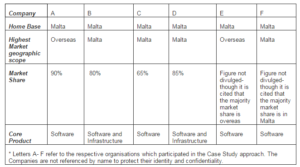
Appendix 2 Interview questions
